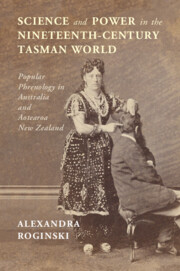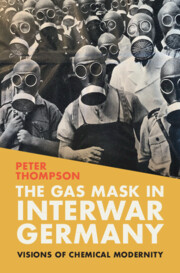Refine search
Actions for selected content:
13587 results in History of science and technology
Contents
-
- Book:
- The Gas Mask in Interwar Germany
- Published online:
- 11 May 2023
- Print publication:
- 25 May 2023, pp vii-vii
-
- Chapter
- Export citation
3 - The First “Chemical Subjects”: Soldier Encounters with the Gas Mask in World War I
-
- Book:
- The Gas Mask in Interwar Germany
- Published online:
- 11 May 2023
- Print publication:
- 25 May 2023, pp 75-104
-
- Chapter
- Export citation
Conclusion
-
- Book:
- The Gas Mask in Interwar Germany
- Published online:
- 11 May 2023
- Print publication:
- 25 May 2023, pp 280-287
-
- Chapter
- Export citation
Tables
-
- Book:
- The Gas Mask in Interwar Germany
- Published online:
- 11 May 2023
- Print publication:
- 25 May 2023, pp ix-ix
-
- Chapter
- Export citation
2 - The Man in the Rubber Mask: World War I and the Development of the Modern Gas Mask
-
- Book:
- The Gas Mask in Interwar Germany
- Published online:
- 11 May 2023
- Print publication:
- 25 May 2023, pp 54-74
-
- Chapter
- Export citation
Index
-
- Book:
- The Gas Mask in Interwar Germany
- Published online:
- 11 May 2023
- Print publication:
- 25 May 2023, pp 323-328
-
- Chapter
- Export citation
Copyright page
-
- Book:
- The Gas Mask in Interwar Germany
- Published online:
- 11 May 2023
- Print publication:
- 25 May 2023, pp iv-iv
-
- Chapter
- Export citation
Hans Radder, From Commodification to the Common Good: Reconstructing Science, Technology and Society Pittsburgh: University of Pittsburgh Press, 2019. Pp. 312. ISBN 978-0-8229-4579-6. $50.00 (hardcover).
-
- Journal:
- The British Journal for the History of Science / Volume 56 / Issue 2 / June 2023
- Published online by Cambridge University Press:
- 24 May 2023, pp. 271-273
- Print publication:
- June 2023
-
- Article
- Export citation

Science and Society in Modern India
-
- Published online:
- 23 May 2023
- Print publication:
- 24 August 2023
Van Leeuwenhoek – the film: remaking memory in Dutch science cinema 1925–c.1960
-
- Journal:
- The British Journal for the History of Science / Volume 56 / Issue 3 / September 2023
- Published online by Cambridge University Press:
- 22 May 2023, pp. 329-349
- Print publication:
- September 2023
-
- Article
-
- You have access
- Open access
- HTML
- Export citation

Science and Power in the Nineteenth-Century Tasman World
- Popular Phrenology in Australia and Aotearoa New Zealand
-
- Published online:
- 18 May 2023
- Print publication:
- 01 June 2023
Representing noise: stacked plots and the contrasting diplomatic ambitions of radio astronomy and post-punk
-
- Journal:
- The British Journal for the History of Science / Volume 56 / Issue 2 / June 2023
- Published online by Cambridge University Press:
- 18 May 2023, pp. 225-245
- Print publication:
- June 2023
-
- Article
-
- You have access
- Open access
- HTML
- Export citation
Cesare Cremonini's non-theological cosmology: a contribution to Padua's secular culture in times of wars of religion
-
- Journal:
- The British Journal for the History of Science / Volume 57 / Issue 4 / December 2024
- Published online by Cambridge University Press:
- 17 May 2023, pp. 561-579
- Print publication:
- December 2024
-
- Article
-
- You have access
- Open access
- HTML
- Export citation

The Gas Mask in Interwar Germany
- Visions of Chemical Modernity
-
- Published online:
- 11 May 2023
- Print publication:
- 25 May 2023
Foreword
-
- Book:
- Star Noise: Discovering the Radio Universe
- Published online:
- 04 May 2023
- Print publication:
- 11 May 2023, pp xi-xiv
-
- Chapter
- Export citation
2 - Radio Emission from the Sun and Stars
-
- Book:
- Star Noise: Discovering the Radio Universe
- Published online:
- 04 May 2023
- Print publication:
- 11 May 2023, pp 41-70
-
- Chapter
- Export citation
12 - Expecting the Unexpected
-
- Book:
- Star Noise: Discovering the Radio Universe
- Published online:
- 04 May 2023
- Print publication:
- 11 May 2023, pp 291-317
-
- Chapter
- Export citation
5 - Radio Astronomy, Cosmology, and Cosmic Evolution
-
- Book:
- Star Noise: Discovering the Radio Universe
- Published online:
- 04 May 2023
- Print publication:
- 11 May 2023, pp 122-142
-
- Chapter
- Export citation
4 - Quasars and AGN
-
- Book:
- Star Noise: Discovering the Radio Universe
- Published online:
- 04 May 2023
- Print publication:
- 11 May 2023, pp 90-121
-
- Chapter
- Export citation
Contents
-
- Book:
- Star Noise: Discovering the Radio Universe
- Published online:
- 04 May 2023
- Print publication:
- 11 May 2023, pp vii-x
-
- Chapter
- Export citation
